

|
| SLOVENSKO | SLOVAKIA |
| Bratislavský kraj | Bratislava region |
| okresy: Bratislava I – V |
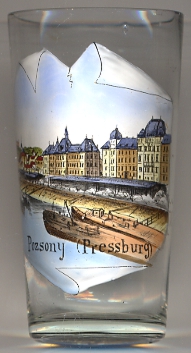 Bratislava, the capital of Slovakia, is situated at an elevation of 140 m on the Danube, directly at the
borders to Austria and Hungary and thus is the only capital city in the world that directly borders on two neighbouring
countries. The modern Slovak name, Bratislava, was officially introduced only in 1919. Before that, its Slovak name
was Prešporok (Hungarian: Pozsony, German: Pressburg, Preßburg).
The city is the country's largest city and has a population of about 425,200 (2005).
Bratislava, the capital of Slovakia, is situated at an elevation of 140 m on the Danube, directly at the
borders to Austria and Hungary and thus is the only capital city in the world that directly borders on two neighbouring
countries. The modern Slovak name, Bratislava, was officially introduced only in 1919. Before that, its Slovak name
was Prešporok (Hungarian: Pozsony, German: Pressburg, Preßburg).
The city is the country's largest city and has a population of about 425,200 (2005).
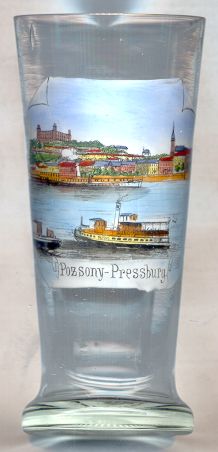 The earliest traces of permanent settlements date from the Neolithic period. Between the 4th and 1st centuries BC the site
was inhabited by Celtic people. Between the 1st and 5th centuries, the Roman border (Limes) went right through this place.
Slavs and Avars arrived in the 6th century. From the end of the 8th century until 833 it belonged to the
principality of Nitra, and from 833 until 907 it was part of Great Moravia. In 907 it became part
of the kingdom of Hungary. From 1536 until 1784 it was the Hungarian capital, from 1542 until 1848 the seat of the Hungarian
diet, and from 1563 until 1830 the coronation site for the kings of Hungary (the Habsburgs since 1526).
The earliest traces of permanent settlements date from the Neolithic period. Between the 4th and 1st centuries BC the site
was inhabited by Celtic people. Between the 1st and 5th centuries, the Roman border (Limes) went right through this place.
Slavs and Avars arrived in the 6th century. From the end of the 8th century until 833 it belonged to the
principality of Nitra, and from 833 until 907 it was part of Great Moravia. In 907 it became part
of the kingdom of Hungary. From 1536 until 1784 it was the Hungarian capital, from 1542 until 1848 the seat of the Hungarian
diet, and from 1563 until 1830 the coronation site for the kings of Hungary (the Habsburgs since 1526).
Following the Battle of Austerlitz (Slavkov u Brna) the (Fourth) Peace of Pressburg of 1805 ended the War of the Third Coalition between France and Austria. Austria had to cede Tirol and Vorarlberg to Bavaria, the other parts of Anterior Austria (see map) were divided between the margraviate (1806 grand duchy) of Baden and the duchy (1806 kingdom) of Württemberg, and Venetia, Istria, Dalmatia and Cattaro (Kotor) fell to the Napoleonic kingdom of Italy. As compensation, the sovereign archdiocese of Salzburg and Berchtesgaden were awarded to Austria, while Emperor Franz II (Franz I of Austria) had to recognize Napoleon as Emperor of France.
From 1919 until 1939 Bratislava was part of Czechoslovakia, from 1939 until 1945 it was the capital of Slovakia. After World War II Slovakia was re-integraetd into the Czechoslovak Socialist Republic and in 1969 the city again obtained the status of capital of the Slovak part. With the separation of the Czech Republic and Slovakia, Bratislava again became the capital of Slovakia in 1993.
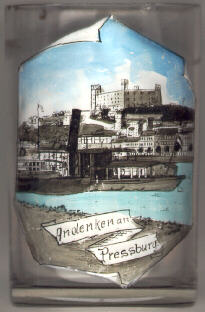
 Bratislava Castle, situated on a plateau 82 m above the Danube, is one of the most conspicuous
buildings of the town. The castle exists since time immemorial, has been the acropolis of a Celtic town, a part of the Roman
Limes Romanus, a huge Slav fortified settlement and a political, military and religious center of Great Moravia. A castle of
stone was built only in the 10th century (part of Hungary), it was turned to a Gothic anti-Hussite fortress in 1430, in 1562
to a Renaissance castle, and in 1649 a Baroque reconstruction took
place. Under Maria Theresa of Austria, Queen of Hungary, the castle was turned into a prestige seat of the royal governor
Albert von Sachsen-Teschen, the son-in-law of Maria Theresa, who founded the Albertina picture
gallery in the castle, which was later moved to Vienna. In 1784, when Pest again became the
capital of Hungary, the castle was turned to a school for Catholic clergy, and later in 1802 to barracks. In 1811, the castle
was inadvertently destroyed by fire by the soldiers of the barracks and was in ruins till the 1950s, when it was reconstructed
mostly in its former Maria Theresa style.
Bratislava Castle, situated on a plateau 82 m above the Danube, is one of the most conspicuous
buildings of the town. The castle exists since time immemorial, has been the acropolis of a Celtic town, a part of the Roman
Limes Romanus, a huge Slav fortified settlement and a political, military and religious center of Great Moravia. A castle of
stone was built only in the 10th century (part of Hungary), it was turned to a Gothic anti-Hussite fortress in 1430, in 1562
to a Renaissance castle, and in 1649 a Baroque reconstruction took
place. Under Maria Theresa of Austria, Queen of Hungary, the castle was turned into a prestige seat of the royal governor
Albert von Sachsen-Teschen, the son-in-law of Maria Theresa, who founded the Albertina picture
gallery in the castle, which was later moved to Vienna. In 1784, when Pest again became the
capital of Hungary, the castle was turned to a school for Catholic clergy, and later in 1802 to barracks. In 1811, the castle
was inadvertently destroyed by fire by the soldiers of the barracks and was in ruins till the 1950s, when it was reconstructed
mostly in its former Maria Theresa style.
[Paragraph taken from http://en.wikipedia.org/wiki/Bratislava]
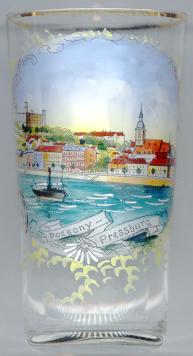
The  Cathedral of St. Martin [background right] is the largest church of Bratislava.
Its construction started at the end of the 13th century on the site of an older, Romanesque, church.
The church was consecrated in 1452. A new long presbytery was built in 1461-1497, the Gothic Czech Queen Chapel and the
St. Anna Chapel were added in the 15th century, and the Baroque chapel of St. John the Merciful was finished in the
first half of 18th century. The important Baroque lead sculpture of St. Martin was created by Georg Rafael Donner in 1734.
In 1760, the top of the Gothic tower was struck by lightning, it was replaced by a Baroque one, which however was destroyed
by fire in 1835 and reconstructed in a different shape in 1847. Also in 1847, a copy of the crown of Hungary weighing
300 kg was placed in the top of tower on a golden pillow as a symbol of importance of the church for coronations
in the years 1563–1830 when Hungarian kings were crowned in this cathedral. The tower has a height of 85 m.
The church has taken its present-day look not before 1869–1877, when it was re-Gothizised.
Cathedral of St. Martin [background right] is the largest church of Bratislava.
Its construction started at the end of the 13th century on the site of an older, Romanesque, church.
The church was consecrated in 1452. A new long presbytery was built in 1461-1497, the Gothic Czech Queen Chapel and the
St. Anna Chapel were added in the 15th century, and the Baroque chapel of St. John the Merciful was finished in the
first half of 18th century. The important Baroque lead sculpture of St. Martin was created by Georg Rafael Donner in 1734.
In 1760, the top of the Gothic tower was struck by lightning, it was replaced by a Baroque one, which however was destroyed
by fire in 1835 and reconstructed in a different shape in 1847. Also in 1847, a copy of the crown of Hungary weighing
300 kg was placed in the top of tower on a golden pillow as a symbol of importance of the church for coronations
in the years 1563–1830 when Hungarian kings were crowned in this cathedral. The tower has a height of 85 m.
The church has taken its present-day look not before 1869–1877, when it was re-Gothizised.
[Paragraph adapted from http://en.wikipedia.org/wiki/http://en.wikipedia.org/wiki/St._Martin%27s_Cathedral]
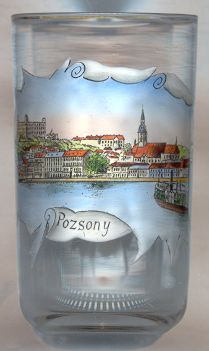
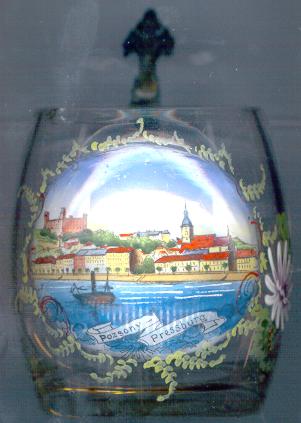
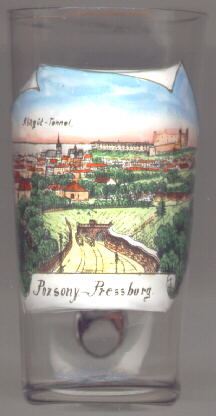

Glass no. 385 [left] is labelled (in Hungarian and German)  Alagút-Tunnel,
while the same view is depicted on glass no. 4732 [right], which is labeled only in German. The view
shows Bratislava from the northeast. The tunnel depicted on the glass was part of the railroad connecting Ofenpest (Budapest
via Poszony (Bratislava) and Marchegg with Vienna. The railroad was commissioned in 1845/1846 in Hungary as
Hungarian Central Railroad (Magyar Középponti Vasút), in Austria as Marchegger Ostbahn (Marchegg Eastern Railroad).
The first train from Vienna to Bratislava ran on 10 August 1848. After its bankrupt the Hungarian Central Railroad company was nationalised in 1850,
now named k.k. Südöstliche Staatsbahn (Imperial-Royal Southeastern State Railroad, and completed the line to Budapest in the same year.
Depicted is the eastern entrance of the tunnel which led from east to west somewhat north of the city of Bratislava (of course, toda it is situated
within the present city boundaries) before the line reached the railroad station of Bratislava.
[Special thanks to Günter Ofner for providing valuable information!]
Alagút-Tunnel,
while the same view is depicted on glass no. 4732 [right], which is labeled only in German. The view
shows Bratislava from the northeast. The tunnel depicted on the glass was part of the railroad connecting Ofenpest (Budapest
via Poszony (Bratislava) and Marchegg with Vienna. The railroad was commissioned in 1845/1846 in Hungary as
Hungarian Central Railroad (Magyar Középponti Vasút), in Austria as Marchegger Ostbahn (Marchegg Eastern Railroad).
The first train from Vienna to Bratislava ran on 10 August 1848. After its bankrupt the Hungarian Central Railroad company was nationalised in 1850,
now named k.k. Südöstliche Staatsbahn (Imperial-Royal Southeastern State Railroad, and completed the line to Budapest in the same year.
Depicted is the eastern entrance of the tunnel which led from east to west somewhat north of the city of Bratislava (of course, toda it is situated
within the present city boundaries) before the line reached the railroad station of Bratislava.
[Special thanks to Günter Ofner for providing valuable information!]
[https://de.wikipedia.org/wiki/Marchegger_Ostbahn, https://de.wikipedia.org/wiki/Südöstliche_Staatsbahn]
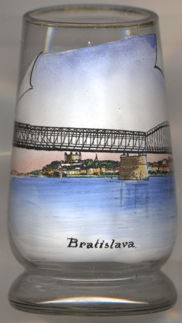
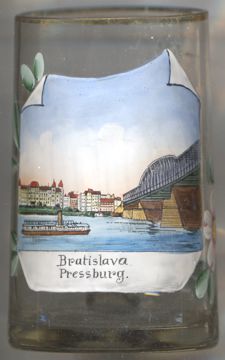
The  'Old Bridge' (Starý most') [near left, no. 3690, right, no. 4511, and below right, no. 3865]
was the oldest bridge across the Danube in Bratislava. The oldest bridge in this site was a pontoon bridge constructed in
1825 and lasted until 1890. The bridge depicted on glass no. 3690 [right] was constructed in 1891
as a steel truss bridge. Named for the Austrian Emperor Franz Joseph I (Kaiser-Franz-Joseph-Brücke), it was
opened by the emperor himself on 9 November of that year. During the Czechoslovak Republic it was named
Štefánikov most for the Slovak politician and general Milan Rastislav Štefánik. Destroyed
during World Waar II it was rebuilt after the war by the Soviet Army using the labour of German prisoners of war.
Until 1972 it was the only bridge across the Danube in Bratislava. After the closure of that bridge in 2008/2010, the
present bridge was constructed in 2014–2016.
'Old Bridge' (Starý most') [near left, no. 3690, right, no. 4511, and below right, no. 3865]
was the oldest bridge across the Danube in Bratislava. The oldest bridge in this site was a pontoon bridge constructed in
1825 and lasted until 1890. The bridge depicted on glass no. 3690 [right] was constructed in 1891
as a steel truss bridge. Named for the Austrian Emperor Franz Joseph I (Kaiser-Franz-Joseph-Brücke), it was
opened by the emperor himself on 9 November of that year. During the Czechoslovak Republic it was named
Štefánikov most for the Slovak politician and general Milan Rastislav Štefánik. Destroyed
during World Waar II it was rebuilt after the war by the Soviet Army using the labour of German prisoners of war.
Until 1972 it was the only bridge across the Danube in Bratislava. After the closure of that bridge in 2008/2010, the
present bridge was constructed in 2014–2016.
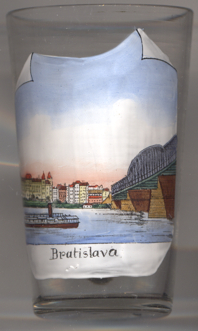 [https://www.wikiwand.com/de/Alte_Br%C3%BCcke_(Bratislava)]
[https://www.wikiwand.com/de/Alte_Br%C3%BCcke_(Bratislava)]
![[scale]](lineal.jpg)